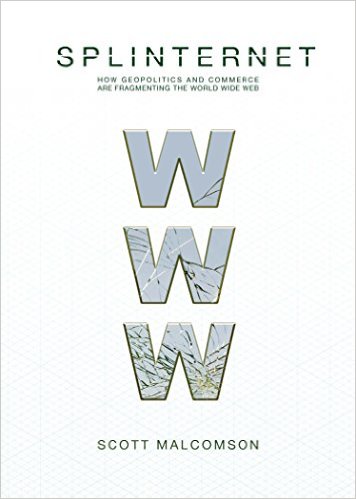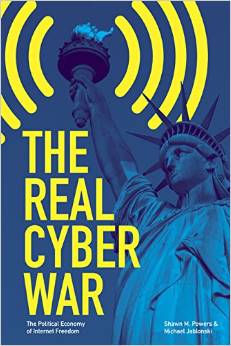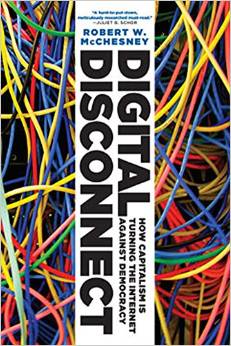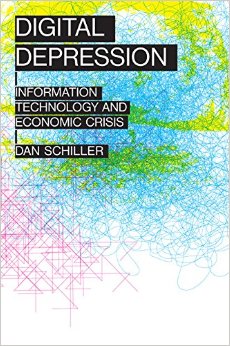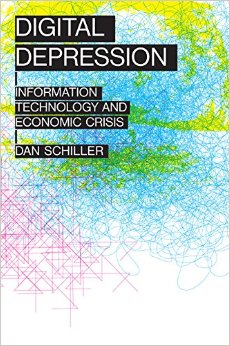a review of Johannes M. Bauer and Michal Latzer, eds., Handbook on the Economics of the Internet (Edward Elgar, 2016)
by Richard Hill
~
The editors of this book must be commended for having undertaken the task of producing it: it must surely have taken tremendous persistence and patience to assemble the broad range of chapters. The result is a valuable book is valuable, even if at some parts are disappointing. As is often the case for a compilation of articles written by different authors, the quality of the individual contributions is uneven: some are excellent, others not. The book is valuable because it identifies many of the key issues regarding the economics of the Internet, but it is somewhat disappointing because some of the topics are not covered in sufficient depth and because some key topics are not covered at all. For example, the digital divide is mentioned cursorily on pp. 6-7 of the hardback edition and there is no discussion of its historical origins, economic causes, future evolution, etc.
Yet there is extensive literature on the digital divide, such as easily available overall ITU reports from 2016 and 2017, or more detailed ITU regional studies regarding international Internet interconnectivity for Africa and Latin America. The historical impact of the abolition of the traditional telephony account settlement scheme is covered summarily in Chapter 2 of my book The New International Telecommunication Regulations and the Internet: A Commentary and Legislative History (2013). One might have expected that a book dedicated to the economics of the Internet would have started from that event and explained its consequences, and analyse proposals regarding how to address the digital divide, for example the proposals made during the World Summit on the Information Society to create some kind of fund to bridge the gap (those proposals were not accepted). I would have expected such a book to discuss the possibilities and the ramifications of an international version of the universal service funds that are used in many countries to minimize national digital divides between low-density rural areas and high-density cities. But there is no discussion at all of these topics in the book.
And there is little discussion of Artificial Intelligence (some of which is enabled by data obtained through the Internet) or of the disruption of labour markets that some believe is or will be caused by the Internet. For a summary treatment of these topics, with extensive references, see sections 1 and 8 of my submission to the Working Group on Enhanced Cooperation.
The Introduction of the book correctly notes that “Scale economies, interdependencies, and abundance are pervasive [in the Internet] and call for analytical concepts that augment the traditional approaches” (p. 3). Yet, the book fails, on the whole, to deliver sufficient detail regarding such analytical concepts, an exception being the excellent discussion on pp. 297-308 of the Internet’s economic environment for innovation, in particular pp. 301-303.
Of the 569 pages of text (in the hardcover edition), only 22 or so contain quantitative charts or tables (eight are in one chapter), and of those only 12 or so are original research. Only one page has equations. Of course the paucity of data in the book is due to the fact that data regarding the Internet is hard to obtain: in today’s privatized environment, companies strive to collect data, but not to publish it. But economics is supposed to be a quantitative discipline, at least in part, so it would have been valuable if the book had included a chapter on the reasons for the relative paucity of reliable data (both micro and macro) concerning the Internet and the myriad of transactions that take place on the Internet.
In a nutshell, the book gives good overall, comprehensive, and legible, descriptions of many trees, but in some cases without sufficient quantitative detail, whereas it mostly fails to provide an analysis of the forest comprised by the trees (except for the brilliant chapter by Eli Noam titled “From the Internet of Science to the Internet of Entertainment”).
The book will be very valuable for people who know little or nothing about the Internet and its economics. Those who know something will benefit from the extensive references given at the end of each chapter. Those who know specific topics well will not learn much from this book. A more appropriate title for the book would have been “A Comprehensive Introduction to the Economics of the Internet”.
The rest of this review consists of brief reviews of each of the chapters of the book. We start with the strongest chapter, followed by the weakest chapter, then review the other chapters in the order in which they appear in the book.
- From the Internet of Science to the Internet of Entertainment
This chapter is truly excellent, as one would expect, given that it is written by Eli Noam. It captures succinctly the key policy questions regarding the economics of the Internet. We cite p. 564:
- How to assure the financial viability of infrastructure?
- Market power in the entertainment Internet?
- Does vertical integration impede competition?
- How to protect children, old people, and traditional morality?
- How to protect privacy and security?
- What is the impact on trade? What is the impact of globalization?
- How to assure the interoperability of clouds?
It is a pity that the book did not use those questions as key themes to be addressed in each chapter. And it is a pity that the book did not address the industrial economics issues so well put forward. We cite p. 565:
Another economic research question is how to assure the financial viability of the infrastructure. The financial balance between infrastructure, services, and users is a critical issue. The infrastructure is expensive and wants to be paid. Some of the media services are young and want to be left to grow. Users want to be served generously with free content and low-priced, flat-rate data service. Fundamental economics of competition push towards price deflation, but market power, and maybe regulation, pull in another direction. Developing countries want to see money from communications as they did in the days of traditional telecom.
Surely the other chapters of the book could have addressed these issues, which are being discussed publicly, see for example section 4 of the Summary of the 2017 ITU Open Consultation on so-called Over-the-Top (OTT) services.
Noam’s discussion of the forces that are leading to fragmentation (pp. 558-560) is excellent. He does not cite Mueller’s recent book on the topic, no doubt because this chapter of the book was written before Mueller’s book was published. Muller’s book focuses on state actions, whereas Noam gives a convincing account of the economic drivers of fragmentation, and how such increased diversity may not actually be a negative development.
Some minor quibbles: Noam does not discuss the economic impact of adult entertainment, yet it is no doubt significant. The off-hand remark at the bottom of p. 557 to the effect that unleashing demand for entertainment might solve the digital divide is likely not well taken, and in any case would have to be justified by much more data.
- The Economics of Internet Standards
I found this to be the weakest chapter in the book. To begin with, it is mostly descriptive and contains hardly any real economic analysis. The account of the Cisco/Huawei battle over MPLS-TP standards (pp. 219-222) is accurate, but it would have been nice to know what the economic drivers were of that battle, e.g. size of the market, respective market shares, values of the respective products based on the respective standards, who stood to gain/lose what (and not just the manufacturers, but also the network operators), etc.
But the descriptive part is also weak. For example, the Introduction gives the misleading impression that IETF standards are the dominant element in the growth of the Internet, whereas it was the World Wide Web Consortium’s (W3C) HTML and successor standards that enabled the web and most of what we consider to be the Internet today. The history on p. 213 omits contributions from other projects such as Open Systems Interconnection (OSI) and CYCLADES.
Since the book is about economics, surely it should have mentioned on pp. 214 and 217 how the IETF has become increasingly influenced by dominant manufacturers, see pp. 148-152 of Powers, Shawn M., and Jablonski, Michael (2015) The Real Cyberwar: The Political Economy of Internet Freedom; as Noam puts the matter on p. 559 of the book: “The [Internet] technical specifications are set by the Steering Group of the Internet Engineering Task Force (IETF), a small group of 15 engineers, almost all employees of big companies around the world.”
And surely it should have discussed in section 10.4 (p. 214) the economic reasons that lead to greater adoption of TCP/IP over the competing OSI protocol, such as the lower implementation costs due to the lack of security of TCP/IP, the lack of non-ASCII support in the early IETF protocols, and the heavy subsidies provided by the US Defence Projects Research Agency (DARPA) and by the US National Science Foundation (NSF), which are well known facts recounted on pp. 533-541 of the book. In addition to not dealing with economic issues, section 10.4 is an overly simplified account of what really happened.
Section 10.7 (p. 222) is again, surprisingly devoid of any semblance of economic analysis. Further, it perpetuates a self-serving, one-sided account of the 2012 World Conference on International Telecommunications (WCIT), without once citing scholarly writings on the issue, such as my book The New International Telecommunication Regulations and the Internet: A Commentary and Legislative History (2013). The authors go so far as to cite the absurd US House proposition to the effect that the Internet should be “free of government control” without noting that what the US politicians meant is that it should be “free of foreign government control”, because of course the US has never had any intent of not subjecting the Internet to US laws and regulations.
Indeed, at present, hardly anybody seriously questions the principle that offline law applies equally online. One would expect a scholarly work to do better than to cite inane political slogans meant for domestic political purposes. In particular when the citations are not used to underpin any semblance of economic analysis.
- The Economics of the Internet: An Overview
This chapter provides a solid and thorough introduction to the basics of the economics of the Internet.
- The Industrial Organization of the Internet
This chapter well presents the industrial organization of the Internet, that is, how the industry is structured economically, how its components interact economically, and how that is different from other economic sectors. As the authors correctly state (p. 24): “ … the tight combination of high fixed and low incremental cost, the pervasive presence of increasing returns, the rapidity and frequency of entry and exit, high rates of innovation, and economies of scale in consumption (positive network externalities) have created unique economic conditions …”. The chapter explains well key features such as multi-sided markets (p. 31). And it correctly points out (p. 25) that “while there is considerable evidence that technologically dynamic industries flourish in the absence of government intervention, there is also evidence of the complementarity of public policy and the performance of high-tech markets.” That is explored in pp. 45 ff. and in subsequent chapters, albeit not always in great detail.
- The Internet as a Complex Layered System
This is an excellent chapter, one of the best in the book. It explains how, because of the layered nature of the Internet, simple economic theories fail to capture its complexities. As the chapter says (p. 68), the Internet is best viewed as a general purpose infrastructure.
- A Network Science Approach to the Internet
This chapter provides a sound and comprehensive description of the Internet as a network, but it does not go beyond the description to provide analyses, for example regarding regulatory issues. However, the numerous citations in the chapter do provide such analyses.
- Peer Production and Cooperation
This chapter is also one of the best chapters in the book. It provides an excellent description of how value is produced on the Internet, through decentralization, diverse motivations, and separation of governance and management. It covers, and explains the differences between, peer production, crowd-sourcing, collaborative innovation, etc. On p. 87 it provides an excellent quantitative description and analysis of specific key industry segments. The key governance patterns in peer production are very well summarized on pp. 108-109 and 112-113.
- The Internet and Productivity
This chapter actually contains a significant amount of quantitative data (which is not the case for most of the other chapters) and provides what I would consider to be an economic analysis of the issue, namely whether, and if so how, the Internet has contributed to productivity. As the chapter points out, we lack sufficient data to analyse fully the impacts of the development of information and communication technologies since 2000, but this chapter does make an excellent contribution to that analysis.
- Cultural Economics and the Internet
This is a good introduction to supply, demand, and markets for creative goods and services produced and/or distributed via the Internet. The discussion of two-sided markets on p. 155 is excellent. Unfortunately, however, the chapter is mostly a theoretical description: it does not refer to any actual data or provide any quantitative analysis of what is actually happening.
- A Political Economy Approach to the Internet
This is another excellent chapters, one of the best in the book. I noted one missing citation to a previous analysis of key issues from the political economics point of view: Powers, Shawn M., and Jablonski, Michael (2015) The Real Cyberwar: The Political Economy of Internet Freedom. But the key issues are well discussed in the chapter:
- The general trend towards monopolies and oligopolies of corporate ownership and control affecting the full range of Internet use and development (p. 164).
- The specific role of Western countries and their militaries in supporting and directing specific trajectories (p. 165).
- How the general trend towards privatization made it difficult to develop the Internet as a public information utility (p. 169).
- The impact on labour, in particular shifting work to users (p. 170).
- The rise and dominance of the surveillance economy (where users become the product because their data is valuable) (p. 175).
- Competition and Anti-Trust in Internet Markets
This chapter provides a very good overview of the competition and anti-trust issues related to the Internet, but it would have been improved if it had referred to the excellent discussion in Noam’s chapter “From the Internet of Science to the Internet of Entertainment.” It would have been improved by referring to recent academic literature on the topic. Nevertheless, the description of key online market characteristics, including that they are often two-sided, (p. 184) is excellent. The description of the actual situation (including litigation) regarding search engines on p. 189 ff. is masterful: a superb example of the sort of real economic analysis that I would have liked to see in other chapters.
The good discussion of network neutrality (p. 201) could have been improved by taking the next step and analysing the economic implications of considering whether the Internet infrastructure should be regulated as a public infrastructure and/or, for example, be subject to functional separation.
- The Economics of Copyright and the Internet
This is an excellent introduction to the issues relating to copyright in the digital age. It provides little data but that is because, as noted on pp. 238-241, there is a paucity of data for copyright, whereas there is more for patents.
- The Economics of Privacy, Data Protection and Surveillance
As one would expect from its author, Ian Brown, this is an excellent discussion of the issues and, again, one of the best chapters in the book. In particular, the chapter explains well and clearly (pp. 250 ff.) why market failures (e.g externalities, information asymmetries and anti-competitive market structures) might justify regulation (such as the European data privacy rules).
- Economics of Cybersecurity
This chapter provides a very good overview of the economic issues related to cybersecurity, but, like most of the other chapters, it provides very little data and thus no detailed economic analysis. It would have benefited from referring to the Internet Society’s 2016 Global Internet Report, which does provide data, and stresses the key market failures that result in the current lack of security of the Internet: information asymmetries (section 13.7.2 of the book) and externalities (section 13.7.3).
However, the section on externalities fails to mention certain possible solutions, such as minimum security standards. Minimum safety standards are imposed on many products, such as electrical appliances, automobiles, airplanes, pharmaceuticals, etc. Thus it would have been appropriate for the book to discuss the economic implications of minimum security standards. And also the economic implications of Microsoft’s recent call for a so-called Geneva Digital Convention.
- Internet Architecture and Innovation in Applications
This chapter provides a very good description, but it suffers from considering the Internet in isolation, without comparing it to other networks, in particular the fixed and mobile telephone networks. It would have been good to see a discussion and comparison of the economic drivers of innovation or lack of innovation in the two networks. And also a discussion of the economic role of the telephony signalling network, Signalling System Seven (SS7) which enabled implementation of the widely used, and economically important, Short Messaging Service (SMS).
In that context, it is important to note that SS7 is, as is the Internet, a connectionless packet-switched system. So what distinguishes the two networks is more than technology: indeed, economic factors (such as how services are priced for end-users, interconnection regimes, etc.) surely play a role, and it would have been good if those had been explored. In this context, see my paper “The Internet, its governance, and the multi-Stakeholder model”, Info, vol. 16. no. 2, March 2014.
- Organizational Innovations, ICTs and Knowledge Governance: The Case of Platforms
As this excellent chapter, one of the best in the books, correctly notes, “platforms constitute a major organizational innovation” which has been “made possible by technological innovation”.
As explained on pp. 338-339, platforms are one of the key components of the Internet economy, and this has recently been recognized by governments. For example, the Legal Affairs Committee of the European Parliament adopted an Opinion in May 2017 that, among other provisions:
Calls for an appropriate and proportionate regulatory framework that would guarantee responsibility, fairness, trust and transparency in platforms’ processes in order to avoid discrimination and arbitrariness towards business partners, consumers, users and workers in relation to, inter alia, access to the service, appropriate and fair referencing, search results, or the functioning of relevant application programming interfaces, on the basis of interoperability and compliance principles applicable to platforms.
The topic is covered to some extent a European Parliament Committee Report on online platforms and the digital single market, (2016/2276(INI). And by some provisions in French law. Detailed references to the cited documents, and to other material relevant to platforms, are found in section 9 of my submission to the Working Group on Enhanced Cooperation.
- Interconnection in the Internet: Peering, Interoperability and Content Delivery
This chapter provides a very good description of Internet interconnection, including a good discussion of the basic economic issues. As do the other chapters, it suffers from a paucity of data, and does not discuss whether the current interconnection regime is working well, or whether it is facing economic issues. The chapter does point out (p. 357) that “information about actual interconnection agreements … may help to understand how interconnection markets are changing …”, but fails to discuss how the unique barter structure of Internet interconnections, most of which are informal, zero-cost traffic sharing agreements, impedes the collection and publication of such information.
The discussion on p. 346 would have benefited from an economic analysis of the advantages/disadvantages of considering the basic Internet infrastructure to be a basic public infrastructure (such as roads, water and electrical power distribution systems, etc.) and the economic tradeoffs of regulating its interconnection.
Section 16.5.1 would have benefited from a discussion of the economic drivers behind the discussions in ITU that lead to the adoption of ITU-T Recommendation D.50 and its Supplements, and the economic issues arguing for and against implementation of the provisions of that Recommendation.
- Internet Business Strategies
As this very good chapter explains, the Internet has had a dramatic impact on all types of businesses, and has given rise to “platformization”, that is the use of platforms (see chapter 15 above) to conduct business. Platforms benefit from network externalities and enable two-sided markets. The chapter includes a detailed analysis (pp. 370-372) of the strategic properties of the Internet that can be used to facilitate and transform business, such as scalability, ubiquity, externalities, etc. It also notes that the Internet has changed the role of customers and both reduced and increased information asymmetries. The chapter provides a very good taxonomy of Internet business models (pp. 372 ff.).
- The Economics of Internet Search
The chapter contains a good history of search engines, and an excellent analysis of advertising linked to searches. It provides theoretical models and explains the important of two-sided markets in this context. As the chapter correctly notes, additional research will require access to more data than are currently available.
- The Economics of Algorithmic Selection on the Internet
As this chapter correctly notes (p. 395), “algorithms have come to shape our daily lives and realities.” They have significant economic implication and raise “significant social risks such as manipulation and data bias, threats to privacy and violations of intellectual property rights”. A good description of different types of algorithms and how they are used is given on p. 399. Scale effects and concentration are discussed (p. 408) and the social risks are explained in detail on pp. 411 ff.:
- Threats to basic rights and liberties.
- Impacts on the mediation of reality.
- Challenges to the future development of the human species.
More specifically:
- Manipulation
- Diminishing variety
- Constraints on freedom of expression
- Threats to data protection and privacy
- Social discrimination
- Violation of intellectual property rights
- Possible adaptations of the human brain
- Uncertain effects on humans
In this context, see also the numerous references in section 1 of my submission to the Working Group on Enhanced Cooperation.
The chapter includes a good discussion of different governance models and their advantages/disadvantages, namely:
- Laissez-fair markets
- Self-organization by business
- Self-regulation by industry
- State regulation
- Online Advertising Economics
This chapter provides a good history of what some have referred to as the Internet’s original sin, namely the advent of online advertising as the main revenue source for many Internet businesses. It explains how the Internet can, and does, improve the efficiency of advertising by targeting (pp. 430 ff.) and it includes a detailed analysis of advertising in relation to search engines (pp. 435 ff.).
- Online News
As the chapter correctly notes, this is an evolving area, so the chapter mostly consists of a narrative history. The chapter’s conclusion starts by saying that “the Internet has brought growth and dynamism to the news industry”, but goes on to note, correctly, that “the financial outlook for news providers, old or new, is bleak” and that, thus far, nobody has found a viable business model to fund the online news business. It is a pity that this chapter does not cite McChesney’s detailed analysis of this issue and discuss his suggestions for addressing it.
- The Economics of Online Video Entertainment
This chapter provides the history of that segment of the Internet industry and includes a valuable comparison and analysis of the differences between online and offline entertainment media (pp. 462-464).
- Business Strategies and Revenue Models for Converged Video Services
This chapter provides a clear and comprehensive description of how an effect of convergence “is the blurring of lines between formerly separated media platforms such as over-the-air broadcasting, cable TV, and streamed media.” The chapter describes ten strategies and six revenue models that have been used to cope with these changes.
- The Economics of Virtual Worlds
This chapter provides a good historical account of the evolution of the internal reward system of games, which went from virtual objects that players could obtain by solving puzzles (or whatever) to virtual money that could be acquired only within the game, to virtual money that could be acquired with real-world money, to large professional factories that produce and sell objects to World of Wonders players in exchange for real-world money. The chapter explores the legal and economic issues arising out of these situations (pp. 503-504) and gives a good overview of the research in virtual economies.
- Economics of Big Data
This chapter correctly notes (p. 512) that big data is “a field with more questions than answers”. Thus, logically, the chapter is mostly descriptive. It includes a good account of two-sided markets (p. 519), and correctly notes (p. 521) that “data governance should not be construed merely as an economic matter but that it should also encompass a social perspective”, a position with which I wholeheartedly agree. As the chapter says (p. 522), “there are some areas affected by big data where public policies and regulations do exist”, in particular regarding:
- Privacy
- Data ownership
- Open data
As the chapter says (p. 522), most evidence available today suggests that markets are not “responding rapidly to concerns of users about the (mis)use of their personal information”. For additional discussion, with extensive references, see section 1 of my submission to the Working Group on Enhanced Cooperation.
- The Evolution of the Internet: A Socioeconomic Account
This is a very weak chapter. Its opening paragraph fails to consider the historical context of the development of the Internet, or its consequences. Its second paragraph fails to consider the overt influence of the US government on the evolution of the Internet. Section 26.3 fails to cite one of the most comprehensive works on the topic (the relation between AT&T and the development of the internet), namely Schiller, Dan (2014) Digital Depression: Information Technology and Information Crisis, University of Illinois Press. The discussion on p. 536 fails to even mention the Open Systems Interconnection (OSI) initiative, yet that initiative undoubtedly affected the development of the Internet, not just by providing a model for how not to do things (too complex, too slow), but also by providing some basic technology that is still used to this day, such as X.509 certificates.
Section 26.6, on how market forces affect the Internet, seems oblivious to the rising evidence that dominant market power, not competition, is shaping the future of the Internet, which appears surprising in light of the good chapter in the book on that very topic: “Competition and anti-trust in Internet markets.” Page 547 appears to ignore the rising vertical integration of many Internet services, even though that trend is well discussed in Noam’s excellent chapter “From the Internet of Science to the Internet of Entertainment.”
The discussion of the role of government on p. 548 is surprisingly lacunary, given the rich literature on the topic in general, and specific government actions or proposed actions regarding topics such as freedom of speech, privacy, data protection, encryption, security, etc. (see for example my submission to the Working Group on Enhanced Cooperation).
This chapter should have started with the observation that the Internet was not conceived as a public network (p. 558) and build on that observation, explaining the socioeconomic factors that shaped its transformation from a closed military/academic network into a public network and into a basic infrastructure that now underpins most economic activities.
_____
Richard Hill is President of the Association for Proper internet Governance, and was formerly a senior official at the International Telecommunication Union (ITU). He has been involved in internet governance issues since the inception of the internet and is now an activist in that area, speaking, publishing, and contributing to discussions in various forums. Among other works he is the author of The New International Telecommunication Regulations and the Internet: A Commentary and Legislative History (Springer, 2014). He writes frequently about internet governance issues for The b2o Review Digital Studies magazine.
Back to the essay




